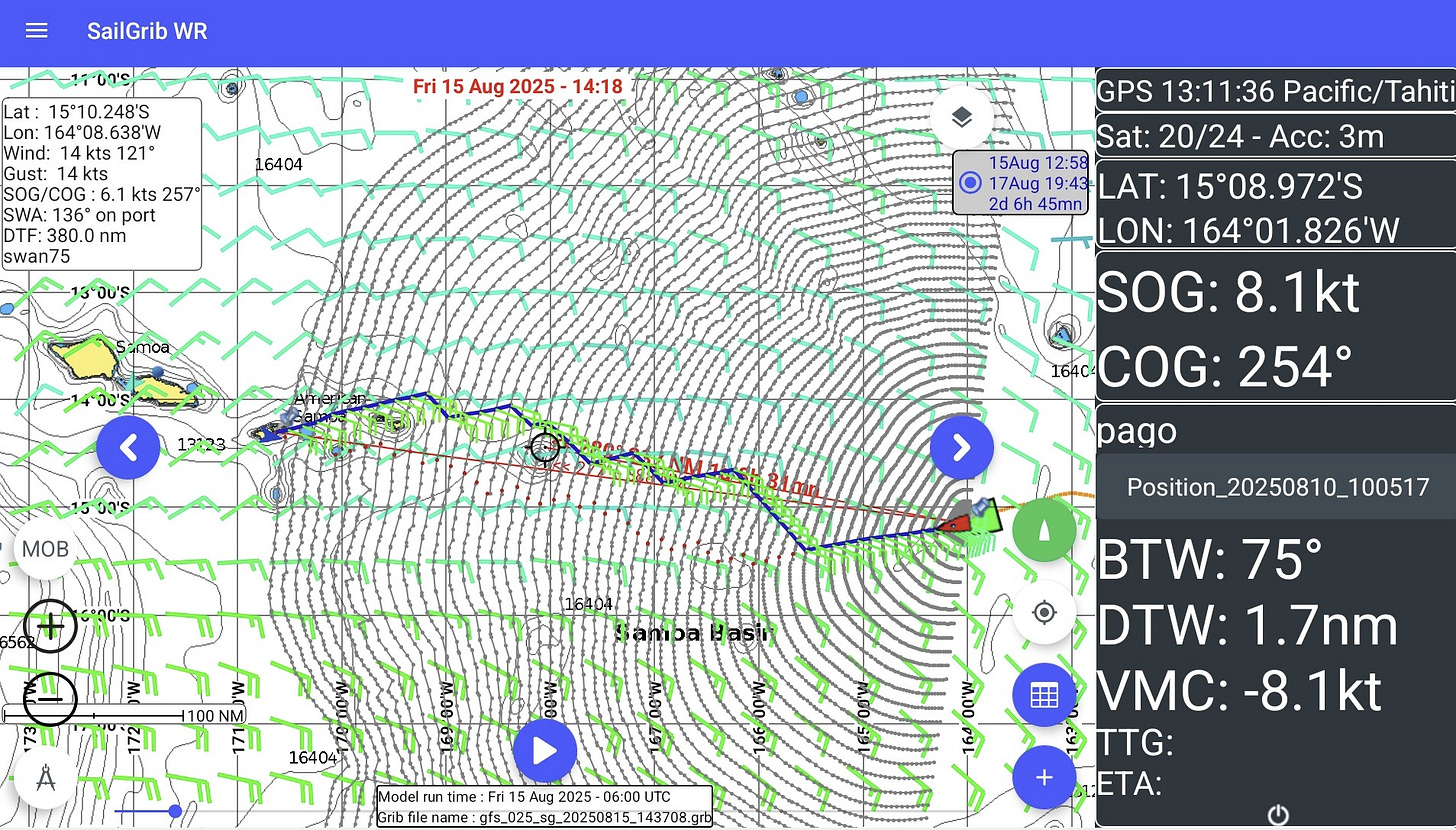Course Planning and Weather Routing
A (very) basic primer on how we find our way across the ocean
“I hate storms, but calms undermine my spirits.”
- Bernard Moitessier, from his book, The Long Way, written in 1971
Whenever we start planning a passage, we spend a lot of time looking at weather forecasts and possible routes, doing our best to pick the right time and the right route that will get us to our destination with optimum speed, comfort, and safety.
The software we use is sophisticated and detailed and gives us the ability to look out 10 days ahead for what we will be up against. But no matter how much we plan, none of this is certain. We are at the mercy of the gods of nature and the sea, and they are a variable bunch. The best forecast is only a prediction. We hope for the best and prepare for the worst.
We are now on Day 6 of our passage from French Polynesia to Samoa, with just less than 400 miles remaining in the 1200-mile trip. We knew from the start that we were going to run into some mixed conditions this week, and sure enough, the wind has been lighter than we expected, with cross swells from different directions. So far, none of the steady trade winds and consistent seas that we had hoped for have shown up for us.
We’d love to be 100% sailing all the time, but in a big boat like Duende, if the seas are boisterous and there is not enough wind to fill the sails and power up the boat, we need to use the engine to assist or we will just wallow around. And if we have no sails up, it’s worse – so we balance sailing and motoring to keep the boat moving and “on her feet”.
This image is a screenshot from our weather routing program. It is what we display on the screen on our navigation dashboard, used to ensure we are sailing an optimal course.
The information is based on weather data models and the sailing capability of our boat and shows animations and real-time data. Without sailor-splaining too much, what you see in this screenshot is the suggested route (the blue line, with the red boat icon representing a moveable position on that line), a direct line to our destination (the rhumb line - shown in red), our current position and course direction (the green boat icon), the wind direction (the way the feather icons are pointing) and the wind speed (indicated by the color of the feather, and the number of lines on the end). We can look out at the prediction for what we will encounter as we move along the suggested course line – and we adjust accordingly.
It all looks great in theory. Today’s reality is that we are working hard to get out from under the edge of a front moving up from the south, and the wind is barely 10 knots. We are motor sailing, as we have been for most of the trip. Consolation, we are making good speed – not always the 8.1 knots as shown in the image, but steady high 7’s. The sea state is what I’d call “messy” with mixed swells, which makes the boat roll more than we like. We have our main sail out, but there isn’t enough wind to keep it full, and it flogs from side to side with the motion of the waves. We have had the head sail out numerous times today, trying to make the most of what wind there is, but we furl it up again when it’s just flogging. And now, it’s raining. Hard. Bad thing, we don’t have the water tank fillers open on deck, so we’re missing out on a great opportunity to catch beautiful pure water. But neither one of us wants to leave the comfort of the pilothouse and go get soaked. Yes, we are wimps.
But there are signs of brightening in the southeast where the weather is coming from. We are hopeful that the trades fill in and the swells line up and that we can turn off the engine and start sailing 100% again before the end of the trip.
Meanwhile, we’re trying to not let “the calms undermine our spirits”, and channel our inner Bernard Moitessier – the OG ocean adventurer.
We sailors are nothing but optimistic – it’s a necessary attribute for success. No matter what we see in the way of conditions for the next few days, I know we will arrive safely in Samoa. And that as always, even with the sophisticated navigation and forecasting tools we have at our disposal, when we drop our hook in yet another new harbor, I’ll be amazed that we managed to find our way to that tiny speck of land in the middle of this big ocean.
Sailing on, LJ
Thanks for reading and being part of the Shellphone Chronicles crew! If at any point this newsletter isn't a good fit, feel free to unsubscribe using the link at the very bottom of this post. No hard feelings!
I’d love to hear from you with questions or ideas for future stories. I respond to every comment you make, feel free to ask me anything.
If you’re just joining the crew, you might want to start at the beginning of this adventure with the Duende Origin Story Part 1 (and 2, and 3, and 4).

